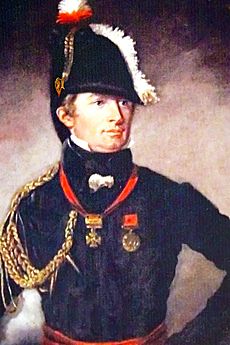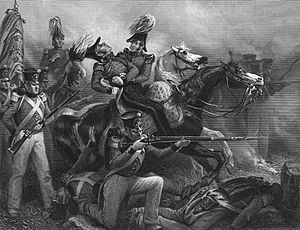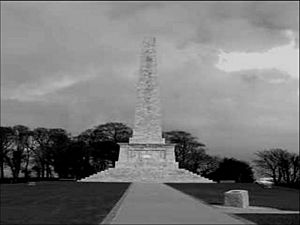Robert Ross (British Army officer) facts for kids
Quick facts for kids
Robert Ross
|
|
|---|---|
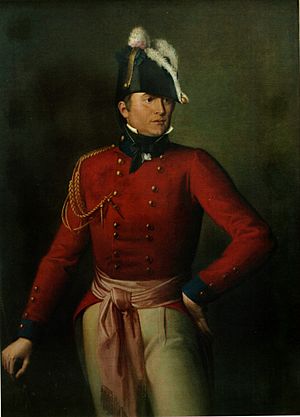 |
|
| Born | 1766 |
| Died | 12 September 1814 (aged 47–48) Baltimore, Maryland, United States
|
| Resting place | Old Burying Ground, Halifax, Nova Scotia |
| Education | Trinity College Dublin |
| Military career | |
| Allegiance | |
| Service/ |
|
| Years of service | 1789–1814 |
| Rank | Major-General |
| Battles/wars | |
Robert Ross (born 1766, died 1814) was an Irish officer in the British Army. He became a Major-General and fought in important conflicts like the Napoleonic Wars and the War of 1812 in North America.
Ross joined the British Army in 1789. He served as an officer in many battles during the Napoleonic Wars. He fought in places like Maida and Corunna, and he was promoted to colonel. In 1809, he went to fight in the Peninsular War in Spain. There, he took part in battles such as Vittoria and Orthez. He was hurt in the neck at the Battle of Orthez in France in February 1814.
Later that year, Ross returned to duty. He was made a major general and sent to North America. He was put in charge of all British forces on the East Coast. In August 1814, he arrived in Benedict, Maryland. He led his soldiers to quickly defeat an American militia at the Battle of Bladensburg on August 24. That evening, he led his troops into Washington D.C..
During his command, the British set fire to many important U.S. Government buildings in what is known as the Burning of Washington. This included the White House and the Capitol. This event greatly damaged the American war effort. Ross then led a British invasion north towards Baltimore. This led to the Battle of Baltimore in September. On September 12, he was shot while leading troops at North Point. He died while being moved away from the battle.
Contents
Early Life and Military Start
Robert Ross was born in Rostrevor, County Down, Ireland. His father, Major David Ross, was an officer who fought in the Seven Years' War. Robert studied at Trinity College Dublin in Ireland. In 1789, he joined the army as an ensign in the 25th Regiment of Foot.
Fighting in the Napoleonic Wars
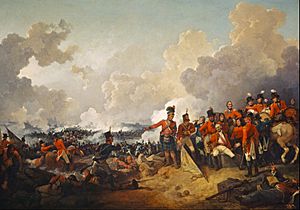
Ross fought as a junior officer in battles like Krabbendam in the Netherlands in 1799. He also fought in the Battle of Alexandria in Egypt in 1801. In 1803, he was promoted to major. He then took command of the 20th Regiment of Foot. His next battle was at Battle of Maida in the Kingdom of Naples in 1806.
Battles in the Peninsular War
At the end of 1808, Ross was promoted to lieutenant–colonel. He fought in the Battle of Corunna in Spain in early 1809. This was during the Peninsular War. In 1810, Ross became a full colonel. He also became an aide-de-camp to the King.
In 1813, Ross served under Arthur Wellesley. He led his regiment in the battles of Vittoria, Roncesvalles, and Sorauren that year. He was badly wounded in the neck at the Battle of Orthez on February 27, 1814. He had just returned to duty when he was given a new command. This command was to lead an expedition to attack the United States.
The War of 1812 Campaigns
Ross sailed to North America as a major general. His job was to take charge of all British troops off the east coast of the United States. He personally led the British troops ashore in Benedict, Maryland. They marched through Upper Marlboro to attack the Americans. This attack happened at the Battle of Bladensburg on August 24, 1814. Ross's professional soldiers easily defeated the American militia.
After Bladensburg, Ross moved towards nearby Washington, D.C.. His horse was shot from under him when he was fired upon. The British burned public buildings in the city. This included the United States Capitol and the White House. This was done as revenge for American attacks on Canada. One notable attack was the Burning of York (now Toronto) in 1813. There is some debate about Ross's choice to destroy public property but save private homes during the burning.
Capturing Washington D.C.
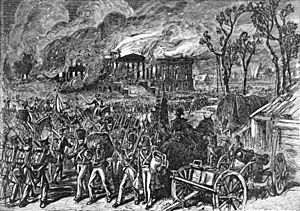
Ross was convinced to attack Baltimore, Maryland, next. He led British troops to that area. A historian noted that Ross "had no intention whatsoever of attacking Washington" at first. However, he marched on the capital. His troops joined others who had arrived from Bermuda, led by Rear-Admiral Sir George Cockburn, 10th Baronet. Even though there were more American defenders, the British captured Washington. They had a force of 4,500 experienced soldiers.
On August 24, the Burning of Washington took place. Ross's troops set fire to several public buildings. These included the White House and the United States Capitol. There was a lot of damage to the inside of these buildings. Ross refused to destroy private property. He even threatened his men with punishment if they did.
A news article once called Ross a "reluctant arsonist." This means he needed to be persuaded by Cockburn to cause damage. Cockburn was hopeful about capturing the capital city. But Ross "never dreamt for one minute that an army of 3,500 men... could march 50 miles inland and capture an enemy capital."
General Ross's Death
On September 12, 1814, Ross's troops landed at North Point. This was about twelve miles southeast of Baltimore. On their way to the Battle of North Point, which was part of the larger Battle of Baltimore, the British met American skirmishers. General Ross rode forward to lead his troops himself. An American sharpshooter shot him through his right arm and into his chest.
Local stories say that two American riflemen, Daniel Wells and Henry McComas, fired at him. One of them fired the shot that killed him. Ross died while he was being carried back to the British ships.
Ross's earlier efforts at the Battle of Bladensburg on August 24, 1814, were praised. He led a clever campaign. He tricked the Americans and stopped them from defending Bladensburg well.
Ross's body was kept in a barrel of rum aboard HMS Tonnant. When the ship went to New Orleans, his body was moved to HMS Royal Oak. He was taken to Halifax, Nova Scotia. He was buried there on September 29, 1814, in the Old Burying Ground.
Robert Ross's Legacy
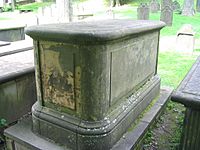
In Ross's home village of Rostrevor, County Down in Northern Ireland, there is a 99-foot granite monument. It is near the shore of Carlingford Lough. This monument was fixed up in 2008. A smaller monument was put up in Kilbroney Parish Church by soldiers who fought with Ross at the Battle of Maida in 1806.
Ross is also remembered by a National Monument in St Paul's Cathedral in London, England. This monument shows Britannia crying over his tomb. A figure of Valour places an American flag on the tomb. Fame comes down with a wreath to honor him.
Ross and his direct family were not given special titles like "knight." However, his family was given a special addition to their family crest. This included a picture of an arm holding the American flag (with 15 stars and 15 stripes) on a broken staff. Their family name was also changed to "Ross-of-Bladensburg" in honor of his victory there.
There is a portrait of Ross in the U. S. Capitol's rotunda. There are also pictures and exhibits about him in various War of 1812 historical sites in the Baltimore area. This includes a monument near where he was shot. More details are kept in places like the Star Spangled Banner Flag House and the Fort McHenry visitor center.
A book about Major-General Ross described him as a soldier who was both careful and brave. His soldiers liked him a lot. This was because he shared their difficulties and fought alongside them. A friend said he could not be "a better man nor a more zealous officer." Ross was also respected by his enemies because he was always polite and honorable.
Local stories say that the two riflemen, Wells and McComas, were buried in a churchyard. Later, in the 1850s, they were moved and reburied in a special tomb in Baltimore. City streets were also named after them.
Images for kids
-
Figure of Major General Robert Ross at the Maryland Museum of Military History
See also
 In Spanish: Robert Ross (militar) para niños
In Spanish: Robert Ross (militar) para niños


